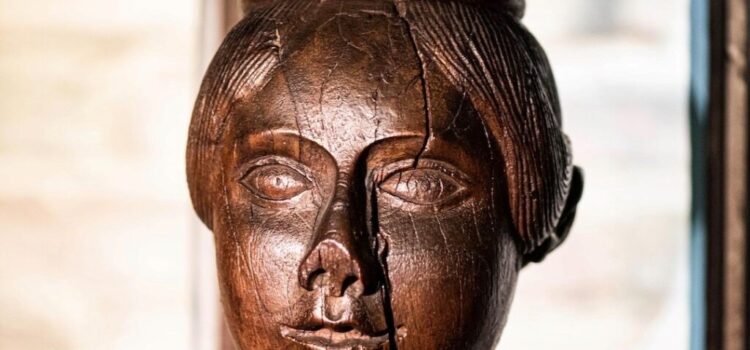As you go up the stairs from the 18th century kitchen at the Museum of Cambridge, you enter a small room that was probably one of the guest rooms at the White Horse Inn. A miscellany of objects, portraits and maps awaits you but perhaps the most prominent object is the beautiful wooden bust on the left, a woman’s head with a crown. In her article on Boat Building,[1] Enid Porter, curator of the museum at the time, refers to this bust of Queen Victoria. It was attached to the horse-drawn pleasure cruiser that took people along the Cam on their excursions to Ely and Clayhithe. The boat was owned by riverside company Fosters.[2]

However, early in 2024, I uncovered a monograph at the museum about a boat called the ‘Viscountess of Bury’[3]. This paper was written by A F Leach in February 1972. He describes a boat having a carved figure-head, complete in Victorian dress and coronet. It sounded familiar. Was our ‘Victoria’ really a Victoria?
The ‘Viscountess of Bury’ is well documented. Leach describes how the boat was built by W S Sargent of Chiswick c.1888 with a very high specification including a triple skinned hull for the Moritz-Immisch[4] Electric Launch Company of Hampton. Revolutionary for the time, the boat was driven by two electric motors each connected to a propellor; under the deck were 200 storage batteries. At the time it was described as the largest electric launch in the world. Of course, at the time there was no public electricity supply so Immisch had its own charging station – a 25 hp steam engine housed on a barge. When fully charged the ‘Viscountess’ could run its two 7 1/2hp motors for 10hrs at full speed, a stately 6 mph.

The origins of the boat throw some light on the rapid development of electric technology in the 19th century. Viscount Bury[5] was in Canada in the 1870s and met Thomas Edison. They became friends and discussed how electric vehicles might be constructed. On his return to the UK Viscount Bury founded the Westminster Electric Traction Co. This failed but an employee, Moritz Immisch, a friend of Viscount Bury, founded the Electric Launch Company in 1880. The Viscount of Bury had meanwhile become a close friend of the Prince of Wales (later Edward VII).
So the ‘Viscountess of Bury’ was constructed: 65 ft long, 10 ft across. Her long keel was a single piece of elm and her carved figurehead represented Sophia, the Viscountess Bury.

Perhaps it was not surprising that such a remarkable boat was chartered by the Prince of Wales himself for four years for excursions on the River Thames; as a result the boat was enlarged and strengthened to increase the number of passengers. After this extraordinary charter, demand for the boat seems to have lapsed. In 1910 it was acquired by the Cambridge firm of H C Banham; the ‘Viscountess’ was by now no longer electric and had been converted to a single petrol engine. It was taken to Cambridge on the North Sea via King’s Lynn. This was a risky journey as the boat was not built for the open sea; on the way to Cambridge it seems to have stopped for a while at Oulton Broad to give pleasure trips. Such was the fame of the boat that there were soon imposters! A boat called the ‘Enchantress’ appeared on postcards labelled ‘The Viscountess Bury’”

Viscountess of Bury at Oulton Broad c.1910
So where does this leave the ‘Victoria’? Our collections officer has recently investigated this elegant carving and discovered that, yes, indeed, the carving was donated to the Folk Museum in 1936 by a Mr R Potter and belonged to the ‘Victoria’ river boat. Curiously, on the back of the carving it says ‘deaf and dumb carver’. Furthermore, experts have questioned whether the carving was actually placed on the boat. It hardly seems to be in the form of a traditional figurehead and some have questioned whether the person depicted is actually Queen Victoria and might in fact date from considerably earlier.
In 1975 the ‘Viscountess Bury’ is described in the Cambridge Press as being moored near the Gas Works on the Cam. She survived until the 1990s and was then discovered derelict at Brandon Creek and was broken up according the account on the East Anglian Waterways Association website.
As for the ‘Victoria’, the WWW seems very silent. If you can help tell her story we would love to hear from you. Is the carving really Queen Victoria? What happened to the vessel itself?
For more information see:
https://www.broadlandmemories.co.uk/blog/2013/10/viscountess-bury-update/
http://www.eawa.co.uk/viscountess.html
[1] CHPL 5 (33) Nov 1971)
[2] https://capturingcambridge.org/museum-of-cambridge/museum-exhibit-stories/fosters-boat-houses/
[3] https://capturingcambridge.org/chesterton-2/cam-road/h-c-banham/
[4] https://en.wikipedia.org/wiki/Moritz_Immisch
[5] https://en.wikipedia.org/wiki/William_Keppel,_7th_Earl_of_Albemarle
